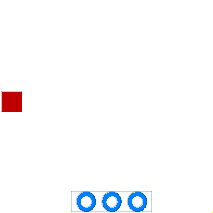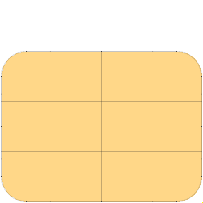 Package Modelica.Fluid.Vessels.BaseClasses
Package Modelica.Fluid.Vessels.BaseClassesBase classes used in the Vessels package (only of interest to build new component models)
 Package Modelica.Fluid.Vessels.BaseClasses
Package Modelica.Fluid.Vessels.BaseClasses
This icon shall be used for a package/library that contains base models and classes, respectively.
Extends from Modelica.Icons.BasesPackage (Icon for packages containing base classes).
| Name | Description |
|---|---|
HeatTransfer … | HeatTransfer models for vessels |
PartialLumpedVessel | Lumped volume with a vector of fluid ports and replaceable heat transfer model |
VesselFluidPorts_a | Fluid connector with filled, large icon to be used for horizontally aligned vectors of FluidPorts (vector dimensions must be added after dragging) |
VesselFluidPorts_b | Fluid connector with outlined, large icon to be used for horizontally aligned vectors of FluidPorts (vector dimensions must be added after dragging) |
VesselPortsData | Data to describe inlet/outlet ports at vessels: diameter -- Inner (hydraulic) diameter of inlet/outlet port height -- Height over the bottom of the vessel zeta_out -- Hydraulic resistance out of vessel, default 0.5 for small diameter mounted flush with the wall zeta_in -- Hydraulic resistance into vessel, default 1.04 for small diameter mounted flush with the wall |
 Partial Model Modelica.Fluid.Vessels.BaseClasses.PartialLumpedVessel
Partial Model Modelica.Fluid.Vessels.BaseClasses.PartialLumpedVessel
This base class extends PartialLumpedVolume with a vector of fluid ports and a replaceable wall HeatTransfer model.
The following modeling assumption are made:
fluidlevel < portsData_height[i] and ports[i].p < vessel_ps_static[i] mass flow at the port is set to 0.
Each port has a (hydraulic) diameter and a height above the bottom of the vessel, which can be configured using the portsData record.
Alternatively the impact of port geometries can be neglected with use_portsData=false. This might be useful for early
design studies. Note that this means to assume an infinite port diameter at the bottom of the vessel.
Pressure drops and heights of the ports as well as kinetic and potential energy fluid entering or leaving the vessel are neglected then.
The following variables need to be defined by an extending model:
input fluidVolume, the volume of the fluid in the vessel,vessel_ps_static[nPorts], the static pressures inside the vessel at the height of the corresponding ports, at zero flow velocity, andWb_flow, work term of the energy balance, e.g., p*der(V) if the volume is not constant or stirrer power.An extending model should define:
parameter vesselArea (default: Modelica.Constants.inf m2), the area of the vessel, to be related to cross flow areas of the ports for the consideration of dynamic pressure effects.
Optionally the fluid level may vary in the vessel, which effects the flow through the ports at configurable portsData_height[nPorts].
This is why an extending model with varying fluid level needs to define:
input fluidLevel (default: 0m), the level the fluid in the vessel, andparameter fluidLevel_max (default: 1m), the maximum level that must not be exceeded. Ports at or above fluidLevel_max can only receive inflow.
An extending model should not access the portsData record defined in the configuration dialog,
as an access to portsData may fail for use_portsData=false or nPorts=0.
Instead the predefined variables
portsData_diameter[nPorts],portsData_height[nPorts],portsData_zeta_in[nPorts], andportsData_zeta_out[nPorts]should be used if these values are needed.
Extends from Modelica.Fluid.Interfaces.PartialLumpedVolume (Lumped volume with mass and energy balance).
| Type | Name | Default | Description |
|---|---|---|---|
Dynamics | energyDynamics | system.energyDynamics | Formulation of energy balance |
Dynamics | massDynamics | system.massDynamics | Formulation of mass balance |
final Dynamics | substanceDynamics | massDynamics | Formulation of substance balance |
final Dynamics | traceDynamics | massDynamics | Formulation of trace substance balance |
AbsolutePressure | p_start | system.p_start | Start value of pressure |
Boolean | use_T_start | true | = true, use T_start, otherwise h_start |
Temperature | T_start | if use_T_start then system.T_start else Medium.temperature_phX(p_start, h_start, X_start) | Start value of temperature |
SpecificEnthalpy | h_start | if use_T_start then Medium.specificEnthalpy_pTX(p_start, T_start, X_start) else Medium.h_default | Start value of specific enthalpy |
MassFraction | X_start[Medium.nX] | Medium.X_default | Start value of mass fractions m_i/m |
ExtraProperty | C_start[Medium.nC] | Medium.C_default | Start value of trace substances |
Integer | nPorts | 0 | Number of ports |
Boolean | use_portsData | true | = false to neglect pressure loss and kinetic energy |
VesselPortsData | portsData[if use_portsData then nPorts else 0] | Data of inlet/outlet ports | |
MassFlowRate | m_flow_nominal | if system.use_eps_Re then system.m_flow_nominal else 100 * system.m_flow_small | Nominal value for mass flow rates in ports |
MassFlowRate | m_flow_small | if system.use_eps_Re then system.eps_m_flow * m_flow_nominal else system.m_flow_small | Regularization range at zero mass flow rate |
Boolean | use_Re | system.use_eps_Re | = true, if turbulent region is defined by Re, otherwise by m_flow_small |
Boolean | use_HeatTransfer | false | = true to use the HeatTransfer model |
| Type | Name | Description |
|---|---|---|
VesselFluidPorts_b | ports[nPorts] | Fluid inlets and outlets |
HeatPort_a | heatPort |
 Record Modelica.Fluid.Vessels.BaseClasses.VesselPortsData
Record Modelica.Fluid.Vessels.BaseClasses.VesselPortsData
This record describes the ports of a vessel. The variables in it are mostly self-explanatory (see list below); only the ζ loss factors are discussed further. All data is quoted from Idelchik (1994).
If a straight pipe with constant cross section is mounted flush with the wall, its outlet pressure loss coefficient will be ζ = 0.5 (Idelchik, p. 160, Diagram 3-1, paragraph 2).
If a straight pipe with constant cross section is mounted into a vessel such that the entrance into it is at a distance b from the wall (inside) the following table can be used. Herein, δ is the tube wall thickness (Idelchik, p. 160, Diagram 3-1, paragraph 1).
| b / D_hyd | ||||||
|---|---|---|---|---|---|---|
| 0.000 | 0.005 | 0.020 | 0.100 | 0.500-∞ | ||
| δ / D_hyd | 0.000 | 0.50 | 0.63 | 0.73 | 0.86 | 1.00 |
| 0.008 | 0.50 | 0.55 | 0.62 | 0.74 | 0.88 | |
| 0.016 | 0.50 | 0.51 | 0.55 | 0.64 | 0.77 | |
| 0.024 | 0.50 | 0.50 | 0.52 | 0.58 | 0.68 | |
| 0.040 | 0.50 | 0.50 | 0.51 | 0.51 | 0.54 | |
If a straight pipe with a circular bellmouth inlet (collector) without baffle is mounted flush with the wall then its pressure loss coefficient can be established from the following table. Herein, r is the radius of the bellmouth inlet surface (Idelchik, p. 164 f., Diagram 3-4, paragraph b)
| r / D_hyd | ||||||
|---|---|---|---|---|---|---|
| 0.01 | 0.03 | 0.05 | 0.08 | 0.16 | ≥0.20 | |
| ζ | 0.44 | 0.31 | 0.22 | 0.15 | 0.06 | 0.03 |
If a straight pipe with a circular bellmouth inlet (collector) without baffle is mounted at a distance from a wall then its pressure loss coefficient can be established from the following table. Herein, r is the radius of the bellmouth inlet surface (Idelchik, p. 164 f., Diagram 3-4, paragraph a)
| r / D_hyd | ||||||
|---|---|---|---|---|---|---|
| 0.01 | 0.03 | 0.05 | 0.08 | 0.16 | ≥0.20 | |
| ζ | 0.87 | 0.61 | 0.40 | 0.20 | 0.06 | 0.03 |
If a straight pipe with constant circular cross section is mounted flush with the wall, its vessel inlet pressure loss coefficient will be according to the following table (Idelchik, p. 209 f., Diagram 4-2 with A_port/A_vessel = 0 and Idelchik, p. 640, Diagram 11-1, graph a). According to the text, m = 9 is appropriate for fully developed turbulent flow.
| m | ||||||
|---|---|---|---|---|---|---|
| 1.0 | 2.0 | 3.0 | 4.0 | 7.0 | 9.0 | |
| ζ | 2.70 | 1.50 | 1.25 | 1.15 | 1.06 | 1.04 |
For larger port diameters, relative to the area of the vessel, the inlet pressure loss coefficient will be according to the following table (Idelchik, p. 209 f., Diagram 4-2 with m = 7).
| A_port / A_vessel | ||||||
|---|---|---|---|---|---|---|
| 0.0 | 0.1 | 0.2 | 0.4 | 0.6 | 0.8 | |
| ζ | 1.04 | 0.84 | 0.67 | 0.39 | 0.18 | 0.06 |
Extends from Modelica.Icons.Record (Icon for records).
| Type | Name | Description |
|---|---|---|
parameter Diameter | diameter | Inner (hydraulic) diameter of inlet/outlet port |
parameter Height | height | Height over the bottom of the vessel |
parameter Real | zeta_out | Hydraulic resistance out of vessel, default 0.5 for small diameter mounted flush with the wall |
parameter Real | zeta_in | Hydraulic resistance into vessel, default 1.04 for small diameter mounted flush with the wall |
 Connector Modelica.Fluid.Vessels.BaseClasses.VesselFluidPorts_a
Connector Modelica.Fluid.Vessels.BaseClasses.VesselFluidPorts_aExtends from Modelica.Fluid.Interfaces.FluidPort (Interface for quasi one-dimensional fluid flow in a piping network (incompressible or compressible, one or more phases, one or more substances)).
| Type | Name | Description |
|---|---|---|
flow MassFlowRate | m_flow | Mass flow rate from the connection point into the component |
AbsolutePressure | p | Thermodynamic pressure in the connection point |
stream SpecificEnthalpy | h_outflow | Specific thermodynamic enthalpy close to the connection point if m_flow < 0 |
stream MassFraction | Xi_outflow[Medium.nXi] | Independent mixture mass fractions m_i/m close to the connection point if m_flow < 0 |
stream ExtraProperty | C_outflow[Medium.nC] | Properties c_i/m close to the connection point if m_flow < 0 |
 Connector Modelica.Fluid.Vessels.BaseClasses.VesselFluidPorts_b
Connector Modelica.Fluid.Vessels.BaseClasses.VesselFluidPorts_bExtends from Modelica.Fluid.Interfaces.FluidPort (Interface for quasi one-dimensional fluid flow in a piping network (incompressible or compressible, one or more phases, one or more substances)).
| Type | Name | Description |
|---|---|---|
flow MassFlowRate | m_flow | Mass flow rate from the connection point into the component |
AbsolutePressure | p | Thermodynamic pressure in the connection point |
stream SpecificEnthalpy | h_outflow | Specific thermodynamic enthalpy close to the connection point if m_flow < 0 |
stream MassFraction | Xi_outflow[Medium.nXi] | Independent mixture mass fractions m_i/m close to the connection point if m_flow < 0 |
stream ExtraProperty | C_outflow[Medium.nC] | Properties c_i/m close to the connection point if m_flow < 0 |